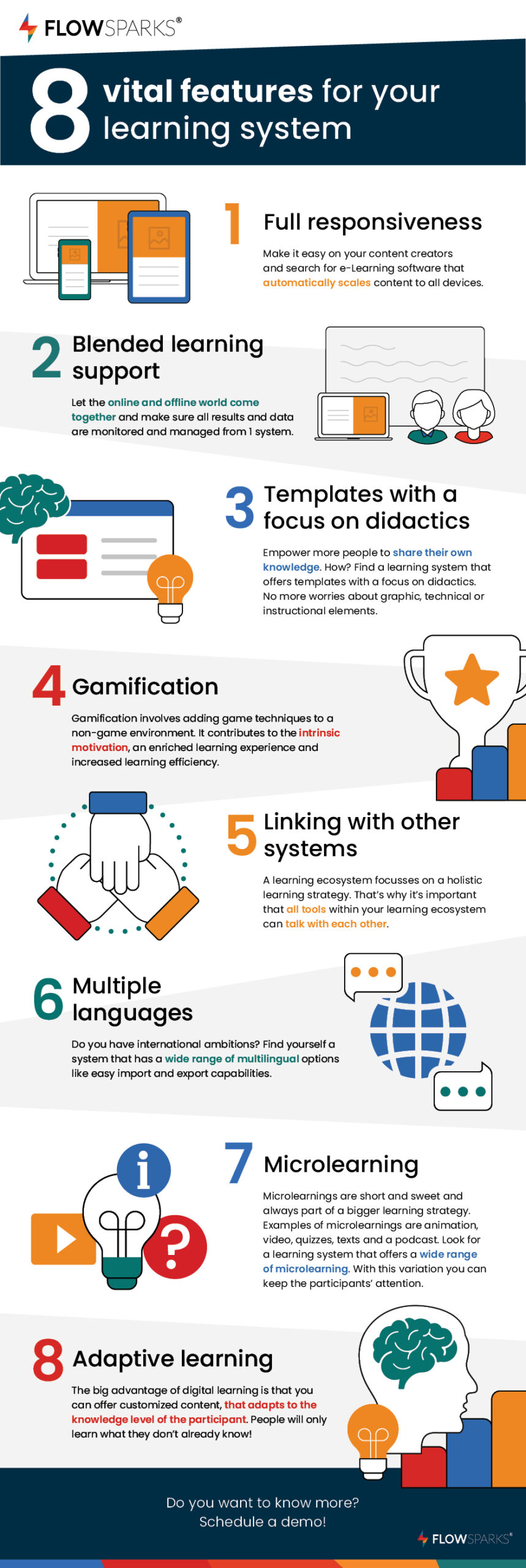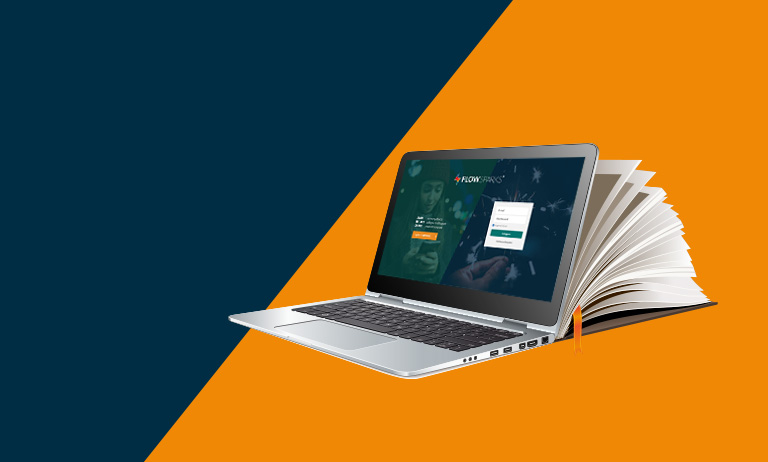8 vital features for your learning system in 2022
- Reading time: 2 minutes
You might have already started with dreaming of how your learning strategy is going to look like in 2022. Happy participants, more creators, improved content and a holistic learning ecosystem. That sounds great, right? Continue reading to find out what features your learning system should have in 2022 to make these dreams come true!
Feature 1: Full responsiveness
Wait what? Are there still tools that don’t offer full responsive content? Yes, there are! Although we are so used to mobile phones and tablets at work and in our personal lives, it is not self-evident that learning content automatically scales to all devices. One of the biggest advantages of online training, is that people can learn at their own convenience, regardless of time and place. By searching for a learning system that supports full responsiveness, it just becomes easier for the participant to follow e-Learning modules from their mobile devices. So make it easy on your content creators and search for e-Learning software that automatically scales content to all devices.
Feature 2: Blended learning support
Blended learning has multiple definitions and purposes, but in this specific case is focused on the combination of online and offline learning. Although online learning is becoming increasingly important, face-to-face contact with other participants and the trainer should not be underestimated, especially in these times where people have less personal interaction with others. A learning system can support your blended learning strategy. Think of software that allows you to create groups of participants. On this system you can serve these groups with both offline and online activities:
- Offline: create schedules or waiting lists and invite the participants to register for offline training sessions.
- Online: create modules that the participants can follow as a preparation for physical training or reference work.
In this way the online and offline world come together, and all results and data are monitored in 1 system.
Feature 3: Templates with a focus on didactics
Want to make big strides with your learning programs in 2022? Get greater support within the organization for developing e-Learning modules and empower more people to share their own knowledge. How? Find a learning system that offers templates with a focus on didactics. Forget about worries for graphic, technical or instructional elements. With these templates the creator only needs to focus on the thing that matters most: the content.
By finding a system that enables your employees to create content, the modules will be more accurate and the development speed for new modules will increase significantly. If you want to boost your learning program in 2022, didactic templates are a must-have.
Feature 4: Gamification
Let the games begin! Or not? Contrary to what the name might suggest, gamification is not about playing a game. Gamification involves adding game techniques to a non-game environment. This is an unmissable feature for your learning system. Gamification elements are used to motivate and challenge participants and this contributes to:
- The intrinsic motivation;
- A more intense involvement;
- An enriched learning experience;
- An increased learning efficiency.
With more and more activities shifting to the digital world and the fact that people will remain working from home now and then, gamification can give that extra push to keep your participants motivated to learn.

Feature 5: Linking with other systems
A term we hear more often is: learning ecosystem. A learning ecosystem focusses on a holistic learning strategy. Tools are not the answer to create a learning ecosystem but they give a basis with which to expand the learning ecosystem. That’s why it’s important that all tools within your learning ecosystem can talk with each other. The ability to make a connection between systems like an authoring tool, LMS, Linkedin Learning, GooddHabitz or a Single Sign-on platform is essential for setting up your learning strategy and ecosystem. This is an important feature of your learning management system.
Feature 6: Multiple languages
Do you have international ambitions in the new year? Find yourself a system that has a wide range of multilingual options. What are the features that make it easy for you to add multiple languages?
- Easy import and export options of your translations so it only takes a few clicks to create new languages.
- Are you sure that the system supports the languages you need? Think of Asian languages or those with a right-to-left direction.
- Check how new languages are added. Do you need to create a new project for every single translation? Or do you simply import a new language layer on top of the existing course? The latter is a lot easier because you don’t have to keep track of the course results per language and you don’t have to pay attention to the media and layout for every single language.
Feature 7: Microlearning
Microlearnings are short and sweet and always part of a bigger learning strategy. Participants focus on specific training topics for only 3-5 minutes. Since microlearnings are most often accessible on mobile devices, they are easy to follow even on a busy working day.
Examples of microlearnings are animation, video, quizzes, texts and a podcast. Look for a learning system that offers a wide range of microlearning. With this variation you can keep the participants’ attention.
Feature 8: Adaptive learning
One size doesn’t fit all! How many times have you experienced that you already know the learning material that’s presented in a book or e-Learning module? The big advantage of digital learning is that you can offer customized content, that suits the knowledge level of the participant.
Adaptive learning adjusts the range of mandatory modules according to the knowledge level of each individual. People will only learn what they don’t already know. This saves time and makes it more fun and less boring to learn, while people with a little less knowledge don’t miss anything and can learn at their own pace.
How can a learning system help to create an adaptive learning program?
- A trainer selects the right modules for the right participant
- A participants themselves select the modules they want to know more of so they create their own learning path
- The learning system offers the possibility to start with an intake test where the knowledge of the participant is tested per topic. Based on this test a participant can get exemptions for the topics with a high score. The other topics are mandatory to follow.
Are you looking for a new learning system to make your learning and development dreams come true?
Request a demo with FLOWSPARKS.

